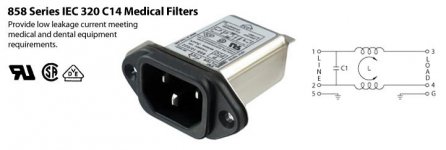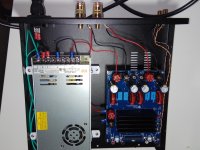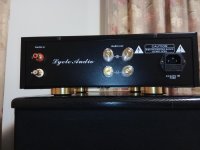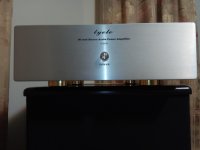Very high pitch whining sound (>14khz) from the amp and/or PS. Not sure which one is it. I will disconnect the fans in my case and then from the power supply one by one and see if the fans are making the sound. Anyone else noticed it though?
Another reason to just get a Connexelectronic PS. No fans, no noise. Compact. Only downside is delivery time. Though Hifimediy does have the 300W and 500W 48v boards. Much faster delivery. Only reason I got the Meanwell is because Hifimediy doesn't carry ~36V for my 3251.
Hi Wushuliu,
Were you able to compare the Connex SMPS vs Mean Well already? Don't mean to rush you,just want to know your opinion before I start building my amp.
Thanks!
I'll have time to do it this weekend. But I say just get the Connex. Less hassle.
The 3255 has no whine in my system. It's silent.
It is pretty good at uncovering noise from a couple of tube preamps when driving efficient speakers. Those preamps are fine with less efficient speakers and lower powered amps so it came as a bit of a surprise. Luckily another one of the preamps seems to have no noise issues so that's the one in the system right now.
The amp does, however, mess up the TV reception of channel 2. If the amp and power supply are on (in a different room) the TV can't get channel 2. Turn the power supply off and the TV works fine. This is repeatable. Channel 3 is fine.

The other thing is that the amp has responded nicely to a power cord upgrade. I know this is something many don't believe in so if it offends you please just accept that some of us play with such things.
The original power cord was an 18 gauge molded cord from a computer that had the female end cut off. The "upgrade" cord was a 14 gauge molded cord that came from a Dell server. The female end was cut off and the male end got upgraded to a Pass & Seymour plug that was lying around unused. If you had to buy the parts it'd probably be about $15 or $20. Nothing exotic. This isn't exotic gear.
Used the same 14 gauge wire to replace 16 gauge that was in between the power supply and the amp. It was also audible.
Having the power cord make a difference in both positions was a bit of a shock. I've heard it happen on other gear but somehow figured this stuff is too cheap and too industrial for such things to matter. It clearly makes a difference. Yeah, it's probably just EMI being filtered a bit but if things improve with cheap parts that are already in the house then why not?
It's a nice amp. Far nicer than it's cost would suggest.
It is pretty good at uncovering noise from a couple of tube preamps when driving efficient speakers. Those preamps are fine with less efficient speakers and lower powered amps so it came as a bit of a surprise. Luckily another one of the preamps seems to have no noise issues so that's the one in the system right now.
The amp does, however, mess up the TV reception of channel 2. If the amp and power supply are on (in a different room) the TV can't get channel 2. Turn the power supply off and the TV works fine. This is repeatable. Channel 3 is fine.
The other thing is that the amp has responded nicely to a power cord upgrade. I know this is something many don't believe in so if it offends you please just accept that some of us play with such things.
The original power cord was an 18 gauge molded cord from a computer that had the female end cut off. The "upgrade" cord was a 14 gauge molded cord that came from a Dell server. The female end was cut off and the male end got upgraded to a Pass & Seymour plug that was lying around unused. If you had to buy the parts it'd probably be about $15 or $20. Nothing exotic. This isn't exotic gear.
Used the same 14 gauge wire to replace 16 gauge that was in between the power supply and the amp. It was also audible.
Having the power cord make a difference in both positions was a bit of a shock. I've heard it happen on other gear but somehow figured this stuff is too cheap and too industrial for such things to matter. It clearly makes a difference. Yeah, it's probably just EMI being filtered a bit but if things improve with cheap parts that are already in the house then why not?
It's a nice amp. Far nicer than it's cost would suggest.
The 3255 has no whine in my system. It's silent.
Used the same 14 gauge wire to replace 16 gauge that was in between the power supply and the amp. It was also audible.
Having the power cord make a difference in both positions was a bit of a shock. I've heard it happen on other gear but somehow figured this stuff is too cheap and too industrial for such things to matter. It clearly makes a difference. Yeah, it's probably just EMI being filtered a bit but if things improve with cheap parts that are already in the house then why not?
It's a nice amp. Far nicer than it's cost would suggest.
Since the only change between power cords is a larger AWG that makes me think that increased current/lower resistance is helpful somehow? I've had larger gauge power cords improve amp performance before. I don't that's particularly controversial. But in a Class D you wouldn't think it should.
This brings up another question which is should we be using the EMI(?) plug filters (like Schurter), etc?
Attachments
Very high pitch whining sound (>14khz) from the amp and/or PS. Not sure which one is it. I will disconnect the fans in my case and then from the power supply one by one and see if the fans are making the sound. Anyone else noticed it though?
I have had a similar issue and found it to be a grounding problem.
Check the grounding of your PS and your input device. In your case, are the input connectors chassis-grounded or floating? They should probably be left floating (insulated from the case). You can check if this is the issue by connecting directly to the board without using any intermediate connectors.
The amp does, however, mess up the TV reception of channel 2. If the amp and power supply are on (in a different room) the TV can't get channel 2. Turn the power supply off and the TV works fine. This is repeatable. Channel 3 is fine.
Don't forget that the amp is a switching device with a frequency that ranges between 430kHz and 470kHz (default). This is in the AM band but if interference is strong enough it can affect other frequencies.
The frequency can be adjusted higher if needed for your environment, up to 625kHz. See page 3 of the user manual.
I would recommend to simply enclose the amp board in an earth-grounded metal box (a Faraday cage). This will also protect the amp from external EMI, which helps preserve its amazing 112dB SNR.
Also, with class D, your speaker wires themselves can emit switching EMI. Twisting the speaker wires (if they are not already of the twisted sort) can help with this.
EDIT:
I have (along with probably most of you) a digitally noisy environment. So I do what I can to improve cell & wifi performance.
A couple of other things I do: 1) Twist the DC +/- power wires between the PS and the amp. This helps to reduce inductance as well as radiated EMI. 2) Use a ferrite choke near the amp's power input for additional filtering. It also helps to keep wiring runs - both power and speaker lines - as short as possible.
If you suspect the power supply is the culprit, the faraday cage is your friend. I didn't catch what PS you're using, but if it is already in a metal case, make sure you are using a grounded 3-prong AC plug.
Last edited:
CCSS, thanks for the detailed response.
I've tried putting a metal pot over the amp and power supply (the mean well 48v 350 watt) but it didn't change anything. It was not grounded, though.
I'll read the manual on page 3 for the frequency.
There's a bit of a mess with the cables right now so removing them and reinstalling them to make sure other wires aren't too close is needed anyway. We'll try a twist where we can.
There's at least one ferrite choke downstairs so thats worth testing. Twisting the wires between power supply and ampwill get tried, too.
The plug on the power supply is grounded.
Thank you for all the suggestions. It may take a bit of time to try them all but it'll happen. Good stuff.
I've tried putting a metal pot over the amp and power supply (the mean well 48v 350 watt) but it didn't change anything. It was not grounded, though.
I'll read the manual on page 3 for the frequency.
There's a bit of a mess with the cables right now so removing them and reinstalling them to make sure other wires aren't too close is needed anyway. We'll try a twist where we can.
There's at least one ferrite choke downstairs so thats worth testing. Twisting the wires between power supply and ampwill get tried, too.
The plug on the power supply is grounded.
Thank you for all the suggestions. It may take a bit of time to try them all but it'll happen. Good stuff.
I have had a similar issue and found it to be a grounding problem.
Check the grounding of your PS and your input device. In your case, are the input connectors chassis-grounded or floating? They should probably be left floating (insulated from the case). You can check if this is the issue by connecting directly to the board without using any intermediate connectors.
Each power supply is grounded using the +/-/GND poles. The amp is connected to the power supply. Since the "case" is nothing but a cardboard box, there is no ground for it. Input to the amp is coming from the Pioneer preamp and output is going to the speakers. The power strip in which both PS are connected is connected to the same one in which preamp is connected. I will still try to lift the ground by using 3-2 pin plug on the strip and see if the sound goes away.
BTW, the sound is not coming from the speakers, since I disconnected the speakers and still the sound is there.
Since the only change between power cords is a larger AWG that makes me think that increased current/lower resistance is helpful somehow? I've had larger gauge power cords improve amp performance before. I don't that's particularly controversial. But in a Class D you wouldn't think it should.
This brings up another question which is should we be using the EMI(?) plug filters (like Schurter), etc?
Gather more consensus, for seek of increased current/lower resistance for SQ amp performance:
For PS: do you just screw the Mains's bare wires, or crimp to connector, or solder to a connector to your SMPS (similarly approach feeding to Class D) ?
For Speaker: do you just screw the Class D output bare wires, or crimp to banana plug, or solder it to the banana plugs ?
BTW, the sound is not coming from the speakers, since I disconnected the speakers and still the sound is there.
oh wow i totally misunderstood. is it coil whine? if so, probably from the PS. Try adjusting the voltage slightly up and and down. That can sometimes make coil whine go away completely or greatly reduce it.
In that case I would not connect reset pins directly, but by two small si-diodes for decoupling.
yep. that worked. thx
Good to know! as I will be using these for the bass and Pass amps for other drivers for a "quad-amped" Linkwitz LX521
What is the gain of the 3255?
What is the gain of the 3255?
agreed, and the gain is just right for bi-amping with an F6.
What is the gain of the 3255?
21.5 dB single ended, 27.5 dB BTL.
Mike
Finally installed the board and PSU (Meanwell) into the chassis. Everything fit inside and still has enough room to work during installation. Unfortunately, I forgot about the reset switch when order the chassis. I do not want to drill a hole on the front panel. Ended up placing a small toggle switch on the right hand side panel as the reset switch.
Really like the sound of this amp. Clear, good bass, great sound stage, a lot of "air" . Thinking of buying a second one. If I am going to assemble a second one, I will get a chassis that has an opening on the front panel for the reset switch
. Thinking of buying a second one. If I am going to assemble a second one, I will get a chassis that has an opening on the front panel for the reset switch .
.
Regards,
Really like the sound of this amp. Clear, good bass, great sound stage, a lot of "air"
Regards,
Attachments
Running Class-D without speakers/load usually is a bad idea.
Got a quick question:
If use only 1 channel of Class-D (without config to PBTL): eg.
L channel with Audio Input, output connected to Speaker.
R channel Audio muted (input shorted), output not connected.
Would this have any risk or any bring about any issue?
- Home
- Amplifiers
- Class D
- TI TPA3255EVM



